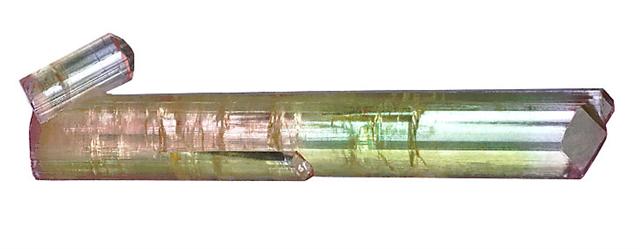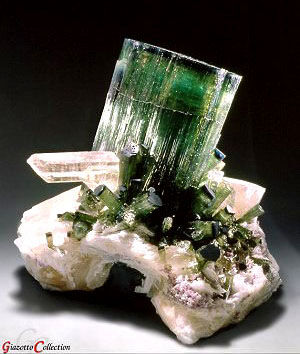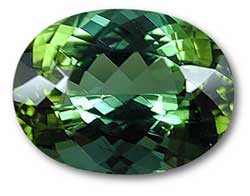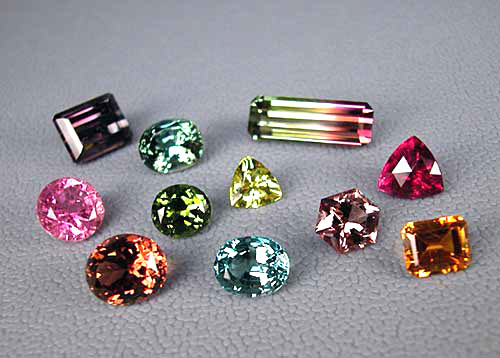Tourmaline

Tourmaline’sname comes from the Sinhalesetura mali,which means “mixed stone.”Available in a rainbow of colours and colour combinations, tourmaline lives up to its name. Legend says tourmaline inspires artistic expression and enhances your intuition. Certainly this gem’s varied palette inspires designers to create jewellery to suit every mood.
Tourmaline offers an enticing rainbow of options for your jewellery wardrobe. Cranberry red, hot magenta, bubblegum pink, peach and orange, canary yellow, mint, grass and forest green, ocean blue, violet, and even bicolour pink and green stones: tourmaline is all these and more.

The most valuable colours of tourmaline are the rare electric blues and greens discovered in Paraiba, Brazil in 1989. Such gems can command tens of thousands of dollars per carat. Blue indicolite, red rubellite, and green chrome tourmaline are also coveted and fine-quality material is hard to find and highly valued.
Pink and mint green tourmaline, however, is widely available and more affordable, with prices in the hundreds of dollars per carat. The Empress Dowager Tz’u Hsi, the last empress of China, loved pink tourmaline above all other gemstones. She imported tons of tourmaline from Southern California in the early twentieth century, creating a gem rush in San Diego during the period.
In addition to unusually varied beauty, tourmaline has unusual electrical properties. Crystals acquire a polarized electrical charge when heated or compressed. This property has also made tourmaline the latest miracle ingredient in moisturizers: manufacturers claim the gem helps pull pollutants from your skin.
Almost every colour of tourmaline can be found in Brazil, especially in Minas Gerais and Bahia. In addition to Brazil, tourmaline is also mined in Tanzania, Kenya, Nigeria, Madagascar, Mozambique, Namibia, Afghanistan, Sri Lanka, and California and Maine in the United States.
Because they grow in thin pencil-like crystals, tourmalines are most often cut into long rectangular shapes known as emerald cuts.
The pink colours of tourmaline can be enhanced with exposure to radiation and some blues and greens improve with heat but the results are stable and undetectable, so no one knows how common these practices are. Red tourmaline, which is often very included, can sometimes have surface-reaching fissures filled with resin to make them less visible.
Tourmaline is durable and suitable for everyday wear. Clean with mild dish soap: use a toothbrush to scrub behind the stone where dust can collect.
Colour is king for Tourmaline, which is found in more hues, shades and nuances than any other gem. Indeed, not only does tourmaline come in every possible color, but some tourmalines have more than one color in the same stone. Here are a few of the more important varieties:
- Rubellite – red
- Indicolite – blue
- Chrome– intense green colored by chromium/vanadium
- Verdelite – occasionally used to describe green tourmaline
- Dravite – brown variety of tourmaline
- Bi-Color – tourmalines which display two or more colors in the same stone
- Watermelon – Bi-color tourmalines which show a green skin and a red core; these are often cut as slices
- Canary – bright yellow tourmaline from Malawi
- Paraíba– intense blue to green from Paraíba, Brazil, colored by copper
- Siberite – purple tourmaline
- Cat’s Eye – chatoyant tourmaline in a variety of colors
- Achroite – colourless tourmaline
- Schorl – black tourmaline
- Colour-change – changes from green in daylight to red in incandescent light

Tour the Tourmaline Rainbow
Pleochroism
One of the more distinctive features of tourmaline is its strong pleochroism, with the ordinary ray colour (the color seen parallel to the c-axis) being deeper than that of the extraordinary ray. In some varieties, this can easily be seen in the face-up position.

The effects of pleochroism can clearly be seen in this oval green tourmaline. Along the vertical axis,
a bluish green color is seen, while along the horizontal axis, the colour is yellowish green.
This is a product of the doubly refractive nature of tourmaline. Photo: Wimon Manorotkul
Lighting. The proper lighting conditions for tourmaline will depend on the color variety. Reds, oranges and yellows generally look best under incandescent light, while greens, blues and violets appear prettier under daylight. When buying any gem, it is always a good idea to examine it under a variety of light sources, to eliminate future surprises.
Clarity.Different varieties of tourmaline tend to have different clarities. Thus while large clean tourmalines in the blue and blue-green colors are available, almost all red and pink tourmalines will show eye-visible inclusions. The most common inclusions in tourmaline are fractures and liquid-filled healed fractures. Needle inclusions are also common.


This suite of electric Paraíba tourmalines shows just why the stone has set the gem world afire. Stones such as this typically sell for tens of thousands of dollars per carat. Photo: Wimon Manorotkul
Cut. The cuts used on tourmaline are as varied as the color. Due to its strong pleochroism, darker tourmalines are cut to display the lighter of the two pleochroic colors. This means orienting the c-axis of the crystal parallel to the table facet. Gems cut with this orientation are often rectangles and rectangular emerald cuts because of the elongated nature of tourmaline crystals.

Tourmalines of lighter color are typically oriented with the table facet perpendicular to the c-axis, to display the richest color possible. Thus they are often cut as rounds, triangles, trillions and ovals. A quick glance at the tourmaline suite shows this.
In addition to faceted stones, cabochon-cut tourmalines are often seen.
Prices. The prices of tourmaline vary tremendously, depending on the variety and quality. Most expensive are the Paraíba tourmalines, which may reach tens of thousands of dollars per carat. Chrome tourmalines, rubellites and fine indicolites and bi-colour may sell for as much as £1,000.00/ct. or more. Other varieties are available for prices between £50.00 – £750.00ct., depending on the richness of the colour.
Stone Sizes. Paraíba tourmalines are extremely rare in faceted stones above 2 cts. Fine Paraíba above 5 carats can be considered world-class pieces. Most stones tend to be less than 1 ct. Chrome tourmalines of quality are rare in sizes above 10 cts., as are rubellites.
Sources. Tourmaline is a pegmatite mineral and so is mined from the world’s great pegmatite districts. Foremost is Brazil, but fine tourmalines are also found in San Diego County, including the famous Pala pegmatite district, and Maine. The East African countries of Kenya, Tanzania, Mozambique and Madagascar have also produced fine tourmaline in the past. Beautiful yellow “canary” tourmalines come from Malawi, while extremely fine rubellites and blue-green tourmalines are found in Nigeria. Afghanistan, Sri Lanka and Burma also produce gem tourmalines on occasion.
Enhancements. Like the color itself, the enhancement possibilities for tourmaline are wide in variety. The resulting stones are stable under normal wearing conditions and completely safe. Heat treatments are used in some instances, while irradiation is used in others. Occasionally tourmaline is oiled to hide the visibility of fractures and other surface-reaching fissures.
Imitations. Tourmaline has never been synthesized, but a number of imitations exist, including natural stones and man-made imitations such as glass.
Properties of Tourmaline
Tourmaline ( A mineral group ) Composition ;
Tourmaline is one of the most complex of all mineral groups, and includes the following species:
- Buergerite: NaFe3+3Al6(BO3)3Si6O18(O)3(OH)
- Chromdravite: NaMg3[Cr,Fe3+]6(BO3)3Si6O18(OH)4
- Dravite: NaMg3Al6(BO3)3Si6O18(OH)4
- Elbaite: Na(Li1.5Al1.5)Al6(BO3)3Si6O18(OH)4
- Feruvite: CaFe2+3[Al5Mg](BO3)3Si6O18(OH)4
- Foitite: [Fe2+2(Al,Fe3+)]Al6(BO3)3Si6O18(OH)4
- Liddicoatite: Ca(Li2Al)Al6(BO3)3Si6O18(OH)4
- Magnesiofoitite: [Mg2+2(Al3+)]Al6(BO3)3Si6O18(OH)4
- Olenite: NaAl3Al6(BO3)3Si6O18(O)3(OH)
- Povondraite: NaFe3+3Fe3+6(BO3)3Si6O18(O)3(OH)
- Rossmanite: (LiAl2)Al6(BO3)3Si6O18(OH)4
- Schorl: NaFe2+3Al6(BO3)3Si6O18(OH)4
- Uvite: CaMg3[Al5Mg](BO3)3Si6O18(OH)4
In summary, tourmaline is a complex aluminum boro-silicate, with heavy emphasis on the “complex.” One pundit likened it more to a medieval alchemist’s brew than a respectable mineral species. And a glance at the above formulae would bear that out.
Hardness (Mohs) :- 7 to 7.5
Specific Gravity :- 3.60 (+ 0.20; – 0.06)
Refractive Index :- 1.624–1.644 (0.18–0.40; usually 0.20, may be greater in dark stones); doubly refractive, uniaxial negative
Crystal System :- Hexagonal-trigonal
Pleochroism :- Strongly dichroic with the ordinary ray having a darker color
Dispersion :- 0.017
Phenomena :- Cat’s eye tourmalines are common. Color-change chrome tourmalines, which change from green to red, are occasionally found.
Handling :- Ultrasonic: generally safe, but risky if the gem contains liquid inclusions Steamer: not safe. The best way to care for tourmaline is to clean it with warm,
soapy water. Avoid exposing it to heat or acids.
Enhancements :- A variety of enhancements are regularly applied to tourmaline, depending on the source and variety. These include heat, irradiation, and oiling.
Synthetic available? :- No

